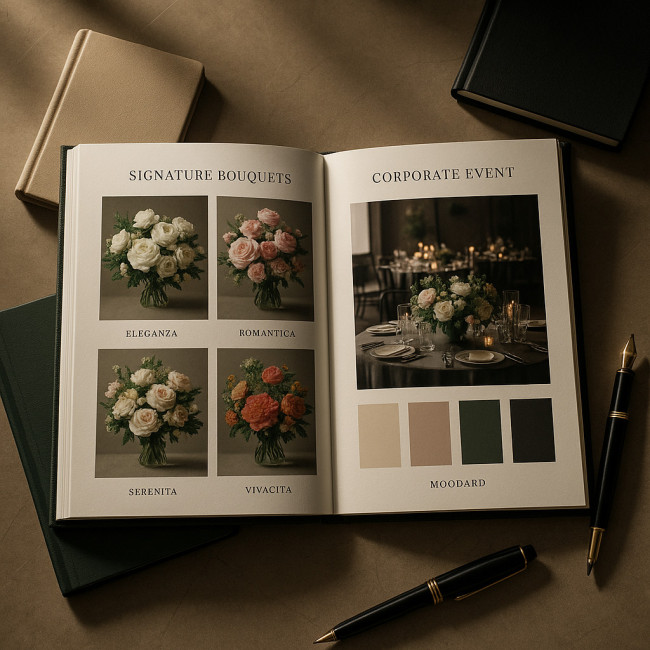Floral artist seasonal contracts: aligning your style with event planner needs
Seasonality drives both flower availability and event-planner demand. By structuring smart seasonal contracts, a floral artist can smooth income, match creative output to peak colour palettes, and become a go-to partner for planners under deadline pressure. Follow this guide to synchronise your signature style with real-world event calendars and secure repeat work all year long.
Why seasonal contracts matter for floral artists

Flowers are perishable, trends evolve fast, and event planners juggle multiple venues. A written seasonal contract creates stability for everyone involved. You lock in purchase volumes and design milestones; planners secure reliable pricing and a recognisable aesthetic across their annual schedule. The result: fewer last-minute scrambles and stronger brand consistency for each event.
Three contract models to know
- Monthly retainers – Ideal for hotels or co-working spaces that refresh lobby arrangements weekly.
- Event bundles – A set number of weddings, galas or launches within one season at a preferential rate.
- Rolling framework agreements – The planner books a minimum spend per quarter, and you provide a flexible mix of bouquets, centrepieces or installations.
Aligning your floral style with event-planner expectations
Your artistic vision is your trademark, yet planners have specific mood boards and corporate colour guidelines. Balancing both creates win-win contracts.
Decode each brief in five minutes
- Identify the primary objective – photo backdrop, scent experience, or brand storytelling.
- Note any colour Pantones or brand marks.
- Confirm venue constraints – ceiling height, lighting, fire codes.
- List must-use blooms versus nice-to-have accents.
- Propose a revision limit in your contract to avoid scope creep.
Palette calendars: when colours shift demand
Soft pastels rule spring weddings, while jewel tones dominate winter gala season. Study booking data or directory analytics to spot these shifts. Our own dashboard—similar to the insights described in how recruiters filter and shortlist floral artists online—shows planners search “blush & sage bouquet” 3× more often from March to May.
Source : Event Industry Forecast 2023
Sync with flower availability
Use local growers whenever possible. This reduces carbon footprint and accelerates installation setup—an approach expanded in our guide on carbon-neutral flower sourcing. Add a “force majeure crop failure clause” so both sides know how substitutions are handled.
Pricing strategies that respect seasonality
Rates vary by bloom cost, labour intensity and venue logistics. A transparent price matrix reassures planners and shields you from underbilling during peak months.
| Season | Typical palette | Labour multiplier | Suggested mark-up |
|---|---|---|---|
| Spring | Pastel ranunculus, tulips | 1.0 | 15 % |
| Summer | Pivotal roses, peonies | 1.2 | 25 % |
| Autumn | Dahlias, dried grasses | 1.1 | 20 % |
| Holiday | Amaryllis, evergreens | 1.3 | 30 % |
For permanent lobby pieces, benchmark against the cost models in pricing permanent floral installations smartly. Your seasonal contract can reference that sheet when a planner requests an evergreen feature wall.
Build revision cycles into the contract timeline
Event planners appreciate clear checkpoints. Map feedback sessions using collaborative 3D previews—learn setup tips in our photogrammetry workflow.
“When we added a mid-season mock-up review, revision hours dropped by 40 % across six venues.” — Studio Fleur
Sample timeline
- Week 0: Contract signed, deposit received.
- Week 1: Mood board, colour swatches and flower list approved.
- Week 4: 3D mock-up delivered for layout feedback.
- Week 6: Final floral procurement order placed.
- Event day: On-site installation and quality check.
Safeguard creative integrity with style clauses

Planners sometimes request last-minute changes that clash with your signature aesthetic. Add a “brand representation” clause stating any major stylistic deviation requires a written addendum and fee review. Pair this with a curated lookbook link, or embed a job-matching snippet from our venue partnership proposal blueprint to demonstrate the value of consistency.
Collaboration tactics that win repeat business
You can meet more planners by positioning your profile on collaboration-focused directories. One high-visibility option is the Artfolio collaboration board for craft designers, where planners post briefs and shortlist talent without endless emails.
- Respond within 24 h – fast replies signal reliability.
- Offer two palette options – align with corporate colours and your creative flair.
- Attach seasonal availability – planners plan months ahead; make decision-making easier.
QUIZ: Are your floral contracts season-ready?
FAQ
- How far in advance should I pitch a seasonal contract?
- Event planners set budgets three to six months ahead. Pitch by early Q4 for spring weddings or by May for holiday galas.
- Can I adjust prices mid-season if flower costs spike?
- Yes. Include a variable pricing clause tied to wholesale indices. Notify the planner at least 14 days before implementing surcharges.
- What insurance do planners expect from a floral artist?
- Public liability covering at least €2 million and product liability for any dyed or preserved blooms that may stain venue surfaces.
- How many venue visits should be included?
- One initial site inspection and one final walkthrough are standard. Extra visits should be billable to protect your margins.
Take the next step
Ready to lock in predictable revenue and showcase your floral artistry across the year? Draft your first seasonal contract today and share your availability calendar with trusted planners. The sooner you align your style with their event timeline, the faster you'll become their preferred partner.
Need help? Download our free checklist and watch bookings bloom.











